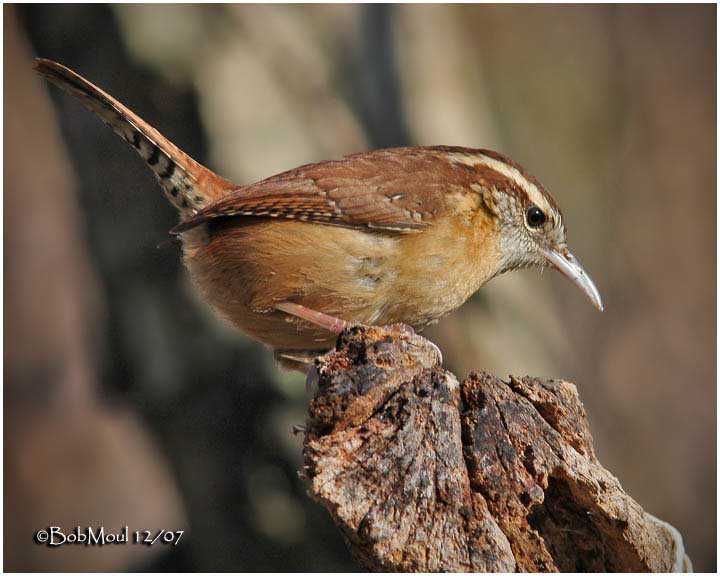
Carolina Wren
Thryothorus ludovicianus
Passeriforme Order – Troglodytidae Family
BIOMETRICS:
Length: 12-14 cm
Wingspan: 29 cm
Weight: 18-22 g
LONGEVITY: up to 6 years
DESCRIPTION:
Carolina Wren has rusty brown upperparts, and warm buff underparts. Chin and throat are white. Wings are barred black, and show two narrow white wing bars. Long tail and undertail coverts are barred black. On the head, we can see a conspicuous white eyebrow, allowing making the difference from other species. Cheeks are paler, brown mottled with white, and extending softly to the warm buff of the underparts.
Decurved bill is long and thin, upper mandible is darker than lower yellowish mandible. Eyes are dark. Legs and feet are pink.
Both sexes are similar, but male is slightly heavier.
Juveniles are similar to adults, but duller.

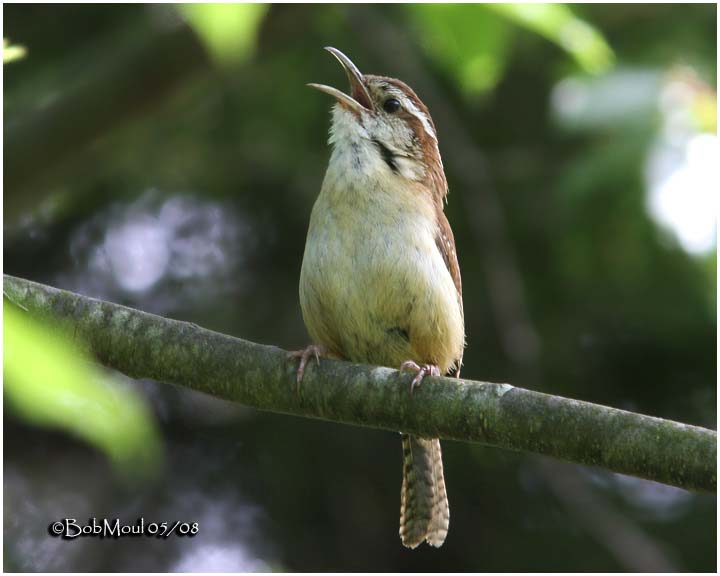
VOICE: SOUNDS BY XENO-CANTO
Carolina Wren utters a melodious song, a loud and clear “teakettle tea – kettle teakettle” or “cheery-cheery-cheery”. It sings at any time of day or year.
The song includes trills, clacks and rattles. Female mostly uses chatters.
HABITAT:
Carolina Wren is common in underbrush in moist woodlands and swamps, and also in wooded suburbs. Dense shrub and brushy cover are two important requirements for their habitat.
RANGE:
Carolina Wren is resident from eastern Kansas to southern Ontario and Massachusetts, and southwards to Gulf Coast and into north eastern Mexico. We can find a population in Yucatan Peninsula.
BEHAVIOUR:
Carolina Wren forages on the ground for insects. It uses its bill to move vegetation, searching under brush piles, in logs and dead timbers, under roots and bark. When occur very cold winter, Carolina Wren retreats to bird feeders.
It feeds primarily on ground, but also climbing tree trunks, prying under bark and into crevices. It also may dismember large insects, hammering with its bill and making small pieces.
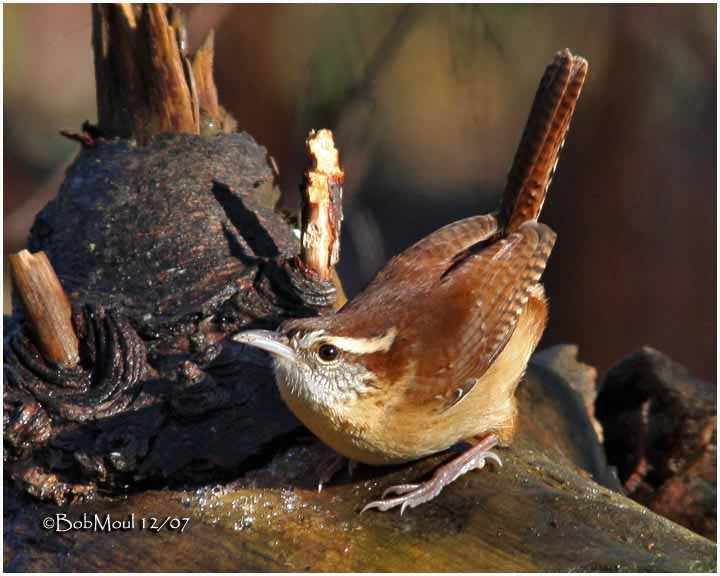
Carolina Wren is monogamous and mates for life. Male performs elaborate courtship display, encircling female with a stiff hopping pattern, and puffing out its feathers with fanned tail. It may bring and offer food to female.
Pair defends its territory, using calls, and some displays, including horizontal body with wings held out, fanned tail, and head and bill pointed at predator or intruder. It may utter an alarm call, and chasing it, sometimes pecking at it.
Carolina Wren is a diurnal bird, and non migratory. It is sensitive to cold winters, and northern birds are decreasing after harsh winters.
When it is moving, its tail is constantly erected. Its rapid motions are fully equal to that of a mouse.
FLIGHT:
Carolina Wren is able to perform short and erratic flights, but not very far. Carolina Wren flies by short flapping of the wings, accompanied by violent jerks of tail and body. It performs a weak and fluttering direct flight, of short duration, with shallow wing beats.
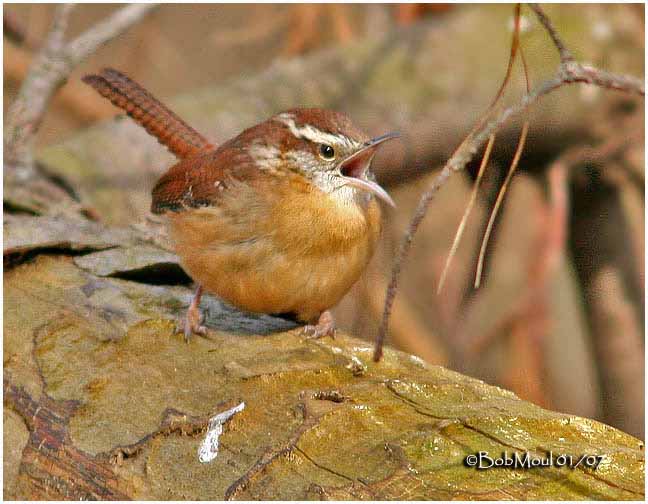
REPRODUCTION:
Carolina Wren’s nest is built by both adults and needs one week of work. It is dome-shaped with an entrance on the side.
These birds nest in a wide variety of sites, as unbelievable as old shoes, coffee pot, or vine tangle, abandoned holes, boxes…
Nest is made with twigs, grasses, weeds, leaves, mosses, pine needles, bark chips, but also hair, string and feathers. It is relatively near the ground, at about 1,80 metre high. Nest is not reused for other broods.
Female lays 3 to 7 eggs, one per day. Eggs are creamy to pinkish white, spotted with dark. Incubation lasts about 12 to 16 days, by female, fed by male during this period. Chicks hatch altricial, and are immediately fed by adults. Female broods them during the first four days.
Young fledge at about 12 to 14 days after hatching. They leave the nest hopping and flying erratically, but parents continue to feed them. Young become independent at about four weeks after fledging, and they reach their sexual maturity at one year.
This species produces two broods in northern parts of its range, and three in southern parts.
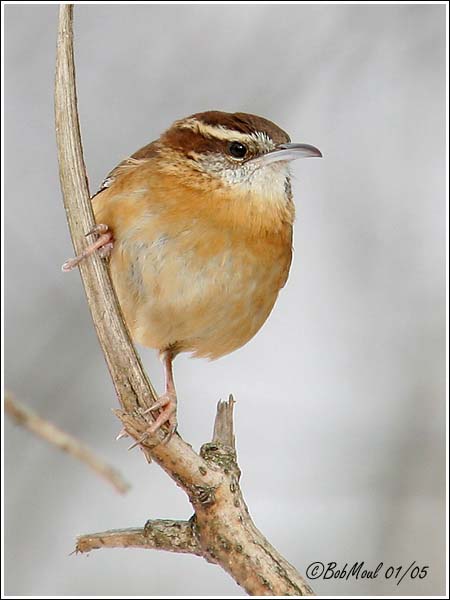
DIET:
Carolina Wren feeds mostly on insects and spiders. Insects may be caterpillars, moths, bugs, beetles, grasshoppers, ants, bees and wasps.
They may consume some vegetable matter, such as berries (poison ivy and others) and sunflower seeds, about 6% of their diet.
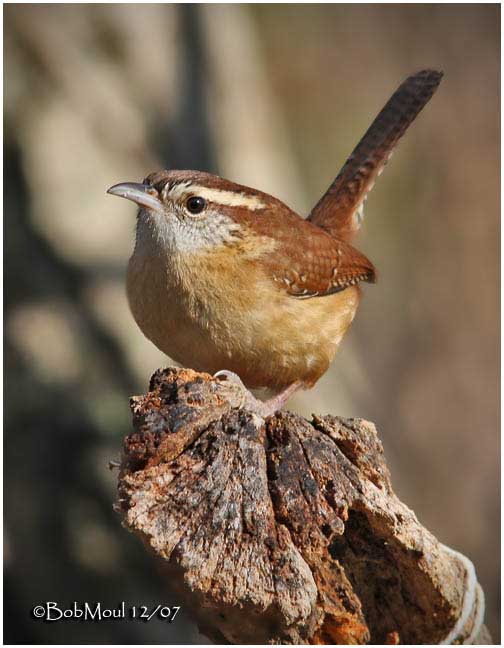
PROTECTION / THREATS / STATUS:
Carolina Wren has some predators, such as jays, hawks and crows. Eggs and chicks are threatened by raccoons, snakes, grey squirrels and foxes.
Nests may be parasitized by Brown-headed Cowbird. However, this species is common and widespread, and its range is increasing.
Fr: Troglodyte de Caroline
All : Carolinazaunkönig
Esp : Ratona Carolinense
Ital : Scricciolo della Carolina
Sd : Karolinagärdsmyg
Photographs by Bob Moul
His website: Nature Photography
Nature Photography
Text by Nicole Bouglouan
Sources :
FIELD GUIDE TO THE BIRDS OF NORTH AMERICA by National Geographic Society - National Geographic Society - ISBN: 0792274512
All About Birds (Cornell Lab of Ornithology)
The Birds of North America online
Animal Diversity Web (University of Michigan Museum of Zoology)
What Bird-The ultimate Bird Guide (Mitchell Waite)
Wikipedia (Wikipedia, The Free Encyclopedia)